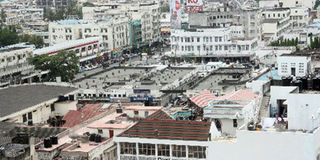There will be no residential houses in Mombasa town by 2040

An aerial view of Mombasa skyline from the G.P.O that is likely to be affected by the new county master plan in this picture taken on January 13, 2016. PHOTO | LABAN WALLOGA
What you need to know:
- County Secretary Francis Thoya says that the plan is for the town to exclusively house businesses by 2040, though the construction of better housing on the outskirts of the town will be given priority in the roll-out process.
- Despite the increase in traffic in Mombasa over in the past few decades, roads have not been expanded, a situation that has resulted in constant traffic jams and congestion within the CBD. Nyali Bridge, which links the island with the town.
- The proposed rail system is also expected to ease the transportation of visitors and residents from Moi International Airport to the North Coast, as well as reduce traffic congestion in Mombasa and Kilifi County’s lower town of Mtwapa.
Mombasa residents, investors and developers, should brace themselves for major upsets and inconveniences as the county government prepares to put in place a new master plan.
The old one, drawn in 1971, expired 10 years ago without being implemented.
Some of the changes the Mombasa Gate City Master Plan proposes are allocation of land for specific purposes within the central business district, including industrial areas. One of the major challenges the county will face, according to Lands, Housing and Planning Executive Anthony Njaramba is relocation.
“We know that relocation is going to be a problem, but we expect residents to understand that it has to be done,” he said.
Worth noting is that the county is no longer approving building plans for residential developments in areas that have been set aside for industrial use.
County Secretary Francis Thoya says that the plan is for the town to exclusively house businesses by 2040, though the construction of better housing on the outskirts of the town will be given priority in the roll-out process.
“It is important to reorganise the city, bearing in mind that in other parts of the world, towns are reserved for businesses, not forgetting that Mombasa is one of the few towns in Kenya where people live within the CBD,” explains Mr Thoya, adding that the construction of residential houses outside the city will precede relocation of the residents.
QUALITY URBAN LIFE
The county is collaborating with developers, the aim being to create satellite towns that will be made up of low-cost houses, and therefore, lower rent, compared to what residents are currently paying.
With the many questions that are bound to arise, the county has put up spirited efforts to sensitise the public to the expected changes. Speaking during a stakeholder’s workshop recently, Mombasa Deputy Governor Hazel Katana said one can only improve the quality of urban life by implementing a proper plan.
“The county wants to engage everyone in shaping the destiny of the city and its environment. We cannot say we live in a city when traffic snarl-ups start at our door-steps. The development master plan will help us to systematically deal with flooding, get rid of raw sewage, and solid waste management,” she said.
To address the transport challenges being experienced in the town, the county government has started negotiations with a Japanese agency to build a mass transport system to link the city to the standard gauge railway (SGR) terminus in Changamwe.
The county is in talks with the national government, and is optimistic that they will get a go-ahead with the project. The railway plan is part of the county’s master plan to reorganise the city by 2040.
Despite the increase in traffic in Mombasa over in the past few decades, roads have not been expanded, a situation that has resulted in constant traffic jams and congestion within the CBD. Nyali Bridge, which links the island with the town, also experiences perennial congestion, which has led to business owners moving their businesses to Nyali Estate onLinks road for convenience.
The national government is upgrading roads in Mombasa, committing huge investments especially in Changamwe and Miritini. According to the county secretary, an efficient mass transport system is necessary to ferry commuters to and from the SGR station in Miritini.
“The county has written a proposal to Japan International Cooperation Agency (JICA) regarding the construction of a post-Miritini terminus connecting railway line,” the county secretary said.
The proposed rail system is also expected to ease the transportation of visitors and residents from Moi International Airport to the North Coast, as well as reduce traffic congestion in Mombasa and Kilifi County’s lower town of Mtwapa.
TRANSFORMATIVE PLAN
“All we need is a nod from the national government. We do not expect them to fund the project; I am sure they will support the initiative,” he said recently, during the sixth International Asia-Africa Seminar for Urban Development, organised by JICA.
It is projected that the rail system will be in place in less than 10 years once approved.
The delegates, who were drawn from several countries in Asia and Africa, observed that the implementation of new city plans in Africa is undermined by changes of government, a lack of consensus among implementers, locals and governments.
Shazly Salleh, a Malaysan panelist at the event, said most transformative plans are shelved because of uncoordinated implementation, noting that the secret of changing cities lies in reconciling the interests of development groups, the people and agencies.
“A harmonised master plan would receive support at the rolling out stage. Mini plans from agencies and individuals cause disharmony. An overall map would also address specific needs in a general way” he said.
Mr Salleh added that there must be dedicated implementing agencies working on the specific aspects of the plan. The agencies, he said, should be semi-autonomous, and report their progress to the local and central government.
Take the Mombasa case for instance – lack of consultation between the government and the county has in the past stalled infrastructure projects due to conflict in relocating landowners.





